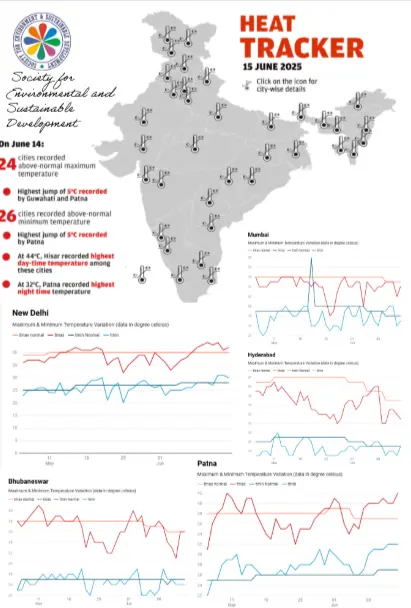Mumbai, Chennai, Delhi, Surat, Thane, Hyderabad, Patna and Bhubaneswar are projected to witness a two-fold increase in heatwave days by 2030, according to a study released June 10, 2025 by development consulting firm IPE Global and GIS technology provider ESRI India.
Unveiled at the International Global-South Climate Risk Symposium in New Delhi, the report titled Weathering the Storm: Managing Monsoons in a Warming Climate offers a district-level assessments of the correlation between extreme heat and erratic rainfall in India. The findings underscored the escalating threat of climate change and call for urgent and localized interventions to strengthen resilience across urban and rural landscapes.
Incessant and erratic rainfall will become more frequent in 8 out of 10 districts in India, the report noted:
“ Our analysis suggests that around 72 per cent of the tier-I & tier-II cities are going to witness an increased occurrences of heat stress and extreme rainfall events, accompanied with storm surges, lightening and hailstorms.”
Meteorological phenomenon like El Nino & La Nina are going to gain stronger momentum, resulting in abrupt surge in climate extremes like flood, cyclones, storm surges and extreme heat.
Coastal districts, in particular, are expected to endure prolonged summer-like conditions even during the peak monsoon months of June through September. Around 69 per cent of coastal districts will be affected by heat stress by 2030, a figure that could rise to 79 per cent by 2040.
Drawing on dynamic climate modelling and spatial analytics, the study documented a stark rise in extreme heat over the last three decades. Between 1993 and 2024, India recorded a 15 times increase in heatwave days during both the March-May and June-September periods. The last decade alone saw a 19-fold surge, with far-reaching implications for human health, agriculture, energy demand and water stress.
“ The growing intensity and frequency of extreme heat and rainfall events across India are no longer rare occurrences — they are signals of a shifting climate reality impacting lives, livelihoods, and infrastructure,” said Agendra Kumar, Managing Director, ESRI India. Addressing them requires a scientific and spatially informed approach.
“ GIS technology offers the ability to visualize and respond to these risks in real-time — whether in city planning, agriculture or disaster response.”
In addition to scientific and governance reforms, the study advocates for risk financing mechanisms to cushion the economic blow of climate-induced disasters.
“ Climate and development pathways are intricately linked. Nearly all countries of the Global South face the dual challenge of improving living conditions for large segments of their population while simultaneously adapting to the consequences of climate change."
India has to bring innovations from margins to the mainstream, he suggested.
" Only then, can India truly emerge as the climate solutions capital to the world”.
